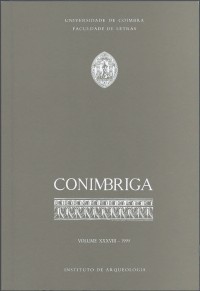Please use this identifier to cite or link to this item:
https://hdl.handle.net/10316.2/45394| DC Field | Value | Language |
|---|---|---|
| dc.contributor.author | Mendes, David Calado | - |
| dc.date.accessioned | 2019-02-07T15:16:30Z | |
| dc.date.accessioned | 2020-09-23T01:27:18Z | - |
| dc.date.available | 2019-02-07T15:16:30Z | |
| dc.date.available | 2020-09-23T01:27:18Z | - |
| dc.date.issued | 1999 | - |
| dc.identifier.issn | 0084-9189 | - |
| dc.identifier.issn | 1647-8657 (PDF) | - |
| dc.identifier.uri | https://hdl.handle.net/10316.2/45394 | - |
| dc.description.abstract | Entre os agricultores do Algarve são comuns as histórias de achados de sepulturas com armas em ferro. No Morgado Dona Menga, Tavira, a descoberta de uma espada, quando da abertura de uma fossa, originou uma intervenção arqueológica de emergência a fim de caracterizar a sepultura. O túmulo, perfeitamente orientado Norte-Sul, era constituído por três elementos distintos, uma cista aparelhada em opus testaceum sobreposta por um covai forrado por tegulce e à superfície um cairn raso com fortes vestígios de queima. O espólio da cista era formado por um copo em vidro, típico do séc. I-II e por uma espada de dois gumes, aparentemente não romana, mas similar às espadas germânicas do Ferro Romano I. A orientação N-S da cista, o uso de cairn e o fogo ritual sobre a sepultura são comuns nas necrópoles germânicas de finais do Ferro Céltico e Ferro Romano, como Sönderholm, Himlingöje e Juellinge. A possibilidade da existência de comunidades germânicas no extremo SW peninsular durante os séculos I e II da nossa era é viabilizada por três acontecimentos históricos: 1. A movimentação da legião Gemina do Reno para a Península, em aproximadamente 74 DC; 2. As invasões dos Mauri no séc. II, que originaram a deslocação para o Sul da península da legião Gemina e tropas vindas da Macedònia; 3. A abertura das fronteiras por Marcus Aurelius, como forma de repovoar os territórios do Império, após as violentas pestes do séc. II. | por |
| dc.description.abstract | In Tavira, Algarve, was newly discovered a warrior’s grave a short sword and a glass from the I ou II century AD. The grave was perfectly oriented North-South and was formed by three main elements: A cist in opus testaceum of lateres crudi covered by heavy stone slabs, superposed by a ditch lined with tegulce. The surface of the grave was delimited by a flat cairn with signs of ritual fires. The orientation of the grave, the cairn and ritual fires, resemble the Germanic graves from late Celtic and Roman Iron Age. Moreover, the deposition of weapons in graves is a most seldom element in the Roman world. In addition, the sword of Tavira seems to be a typical Germanic double edged sword from the early Roman Iron Age. The possible existence of Germanic colonies in the extreme SW of the empire so early as the I or II century AD could be historically explained by three facts: 1. The displacement of the legio Gemina from the limes to Iberia in 74 AD; 2. The Mauri invasions of the II century, that forced the moviment of the legio Gemina to the Southern Iberia as well as the arrival of Roman troops from Macedonia; 3. The opennig of the limes by Marcus Aurelius after the violent plagues of the II century AD. | eng |
| dc.language.iso | por | - |
| dc.publisher | Imprensa da Universidade de Coimbra | - |
| dc.rights | open access | - |
| dc.title | A sepultura do séc. II de um guerreiro com espada: (Morgado Dona Menga - Tavira) | por |
| dc.type | article | - |
| uc.publication.collection | Conimbriga vol. 38 | - |
| uc.publication.firstPage | 215 | - |
| uc.publication.lastPage | 223 | - |
| uc.publication.location | Coimbra | - |
| uc.publication.journalTitle | Conimbriga: Revista de Arqueologia | - |
| uc.publication.volume | 38 | por |
| dc.identifier.doi | 10.14195/1647-8657_38_9 | - |
| uc.publication.orderno | 9 | - |
| uc.publication.area | Artes e Humanidades | - |
| uc.publication.manifest | https://dl.uc.pt/json/iiif/10316.2/45394/235850/manifest?manifest=/json/iiif/10316.2/45394/235850/manifest | - |
| uc.publication.thumbnail | https://dl.uc.pt/retrieve/11530099 | - |
| item.grantfulltext | open | - |
| item.fulltext | With Fulltext | - |
| Appears in Collections: | Conimbriga | |
Files in This Item:
| File | Description | Size | Format | |
|---|---|---|---|---|
| a_sepultura_do_sec._ii.pdf | 1.55 MB | Adobe PDF |  |
Items in DSpace are protected by copyright, with all rights reserved, unless otherwise indicated.
